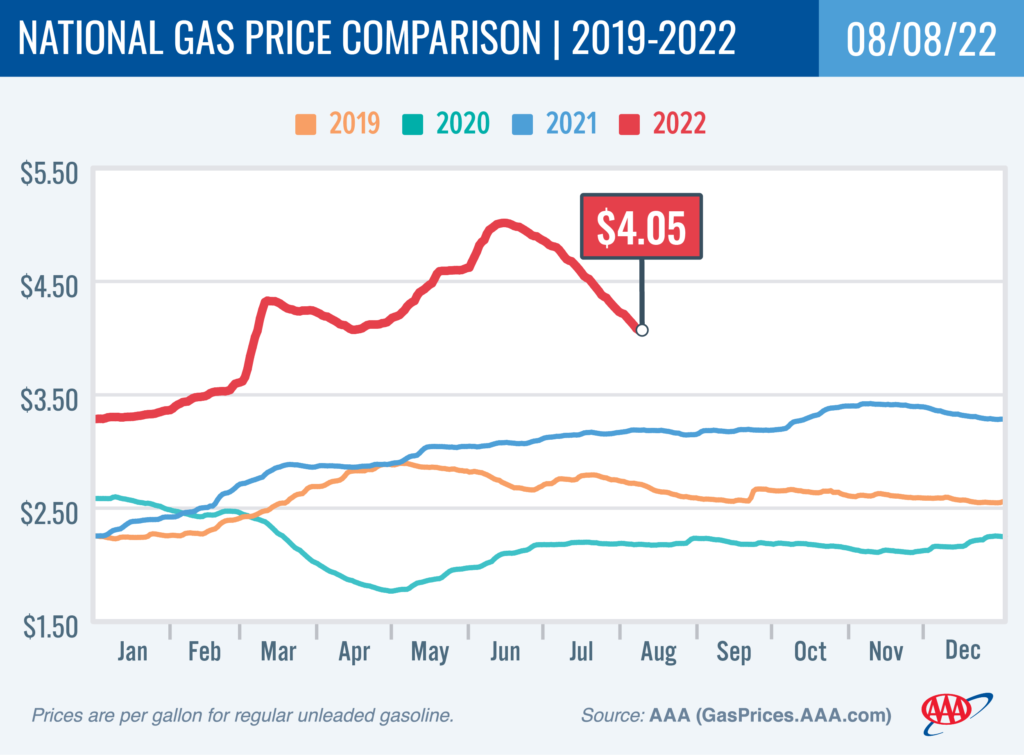WASHINGTON, D.C. — Despite steadily falling gas prices during the peak of the summer driving season, fewer drivers fueled up last week. It’s another sign that, for now, Americans are changing their driving habits to cope with higher pump prices. Meanwhile, the cost of oil has edged lower on fears of economic slowdowns elsewhere around the globe. Because of these factors, the national average for a gallon of gas fell to $4.05.
“Oil is the primary ingredient in gasoline, so less expensive oil is helpful in taming pump prices,” said Andrew Gross, AAA spokesperson. “Couple that with fewer drivers fueling up, and you have a recipe for gas prices to keep easing. It’s possible that the national average will fall below $4 this week.”
According to new data from the Energy Information Administration (EIA), gas demand dropped from 9.25 million b/d to 8.54 million b/d last week. The rate is 1.24 million b/d lower than last year and is in line with the need at the end of July 2020, when COVID-19 restrictions were in place and fewer drivers hit the road. Moreover, according to EIA, the total domestic gasoline supply rose slightly by 200,000 bbl to 225.3 million bbl. If gas demand remains low and the supply continues to increase alongside falling oil prices, drivers will likely continue to see pump prices drop.
AAA finds that drivers made significant changes to cope with high pump prices. In a new survey, almost two-thirds of U.S. adults have changed their driving habits or lifestyle since March. Drivers’ top two changes to offset high gas prices are driving less and combining errands.
Today’s national average of $4.05 is 67 cents less than a month ago and 87 cents more than a year ago.

Quick Stats
- The nation’s top 10 largest weekly decreases: Washington, D.C. (−28 cents), Colorado (−23 cents), Arizona (−21 cents), Illinois (−21 cents), Indiana (−21 cents), Iowa (−20 cents), Ohio (−20 cents), Michigan (−19 cents), Missouri (−18 cents) and Minnesota (−18 cents).
- The nation’s top 10 least expensive markets: Texas ($3.55), South Carolina ($3.59), Oklahoma ($3.60), Arkansas ($3.60), Georgia ($3.61), Tennessee ($3.62), Mississippi ($3.62), Alabama ($3.64), Kansas ($3.66) and Iowa ($3.66).
Oil Market Dynamics
At the close of Friday’s formal trading session, WTI increased by 47 cents to settle at $89.01. Although crude prices made slight gains on Friday due to a strong U.S. jobs report for July, they saw significant declines throughout the week as a result of continuing market concern that demand will decline if economic growth stalls or reverses course. Prices have not been this low since mid-February 2022—before Russia invaded Ukraine. Additionally, EIA reported that total domestic crude supply increased by 4.5 million bbl to 426.6 million bbl. The sharp inventory increase, during the usually high-demand summer driving season, signals low demand could continue pushing prices lower. For this week, crude prices could continue to decline if demand concerns persist.
Drivers can find current gas prices along their route using the AAA TripTik Travel planner.
